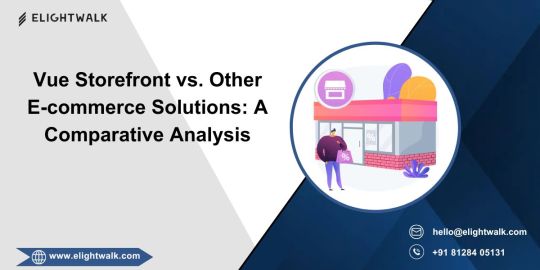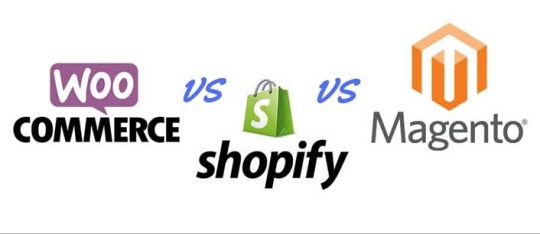#Magento vs Shopify
Text
Which platform is more secure? Magento or Shopify?
When it comes to evaluating the security of e-commerce platforms like Magento and Shopify, it's important to consider a variety of factors. Here are some criteria you can use to compare the security of these two platforms:
SSL Encryption: SSL encryption is a key feature that ensures all data transmitted between the server and the client is encrypted, protecting sensitive information like credit card numbers and login credentials. Both Magento and Shopify offer SSL encryption, but the implementation and strength of the encryption may vary.
Payment Card Industry Data Security Standard (PCI DSS) Compliance: PCI DSS is a set of security standards that all merchants must follow to protect customer payment data. Both Magento and Shopify are PCI DSS compliant, but the level of compliance and certification may vary depending on the plan you choose.
Vulnerability Management: It's important for e-commerce platforms to have a robust vulnerability management process in place to identify and mitigate security threats. Both Magento and Shopify provide security updates and patches to address vulnerabilities, but the speed and frequency of these updates may differ.
Two-Factor Authentication: Two-factor authentication is an additional layer of security that requires users to provide two forms of identification to access their account. Magento offers two-factor authentication as a standard feature, while Shopify offers it as an optional add-on.
Brute Force Protection: Brute force protection is a security measure that prevents attackers from guessing a user's password through repeated login attempts. Magento and Shopify both offer brute force protection, but the level of protection may vary.
Codebase Scanning: Codebase scanning involves scanning the code of an e-commerce platform for potential security vulnerabilities. Magento offers codebase scanning as a built-in feature, while Shopify offers it through a third-party app.
2 notes
·
View notes
Text
Magento vs Shopify: Which E-commerce Platform is Right for Your Business?
Introduction
Choosing the right e-commerce platform is crucial for the success of your online business. With so many options out there, it can be hard to decide which one to go with. Two of the biggest names in the game are Magento and Shopify. But which one is right for you? Let’s dive into a detailed comparison to help you decide.
Overview of Magento
Magento is an open-source e-commerce…

View On WordPress
0 notes
Text
Unleash the potential of BigCommerce B2B for your online store. Empower your business-to-business e-commerce operations with the robust capabilities of BigCommerce. From personalized pricing and account management to streamlined order processes, this solution offers the tools you need to create a seamless and efficient B2B shopping experience. Discover how BigCommerce B2B can transform your online store into a powerful platform for business customers.
#magento developer#magento developers#magento development services#magento ecommerce#shopify vs magento#magento vs shopify#magento integrations#ecommerce website design#magento 1 to magento 2 migration#magento 1 vs magento 2#migrate magento 1 to magento 2#magento 1 to 2 migration
1 note
·
View note
Text
Magento vs Shopify: Which Is The Best eCommerce Platform For You?
In conclusion, both Magento vs Shopify have their merits. The best choice depends on your specific business needs, technical expertise, budget, and growth expectations. Take your E-commerce business to the next level so, hire e-commerce developer now.
#web development#business#hire e-commerce developer#ai for web development#magento#shopify#Magento vs shopify#wordpress development#wordpress web design#wordpress development services#hire wordpress developers#woocommerce development#hire woocommerce developer#woocommerce development services
1 note
·
View note
Text
MAGENTO VS. SHOPIFY, WHICH ONE IS THE BEST?
Introduction

Magento vs Shopify is a debate that has been going on for a long time. Both these platforms are very popular and are used by thousands of businesses around the world. This is one of the initial choices you must make if you want to launch an eCommerce store.
As we all know, Magento is one of the most powerful eCommerce platforms out there today, with great features like SEO-friendly URLs, multiple currencies, and integrated payment gateways. However, Shopify has also improved its platform significantly over the years, and now it provides many advanced features at an affordable price point which makes it hard to choose between these two platforms.
What is the difference between Magento and Shopify?
In this article, I will be comparing both platforms based on different aspects such as pricing, ease of use, etc., so that you can decide which one suits your needs better!
Pricing and Cost

Magento vs Shopify pricing and cost, which one is cheaper?
Both Shopify and Magento require an initial investment, but the monthly costs to keep both platforms going are significantly different.
Shopify is all-inclusive; you pay a set price for their service that includes everything you need, including hosting and security. You can also choose from several different subscription plans based on your needs.
Magento’s pricing is much more variable and depends on the size of your store and business goals (for example, if you have a goal of selling products internationally).
Themes and Templates

Magento vs Shopify, which one has better themes and templates? This is another difference between Magento and Shopify.
Shopify offers a wide selection of themes and templates. However, Magento provides fewer options for customization.
Shopify’s themes are easier to customize than Magento’s because they have drag and drop builder interface, which makes the process very simple.
Ease of use

Magento vs Shopify, which one is more user-friendly? What is the difference between Magento and Shopify when it comes to ease of use and user-friendliness?
Shopify is a simple and easy-to-use platform.
The platform is user-friendly, and it has a lot of built-in features that make it easier for entrepreneurs to do their business online.
If you are a beginner or newbie when it comes to eCommerce, then Shopify will be the perfect fit for you as it provides everything that an entrepreneur needs to run an online business.
You can easily create and customize your store without any coding knowledge or experience by utilizing Shopify’s options, such as themes and apps, which are available at the click of your finger.
Apps and Extensions

Magento vs Shopify, which one offers better apps and extensions?
Magento has a lot of apps and extensions available, but Shopify is better in this regard. With Shopify, you can add so many things to your eCommerce store, like payments, accounting software like Quickbooks, etc. It also has some very advanced features like the ability to customize the cart according to your requirements and add product reviews etc.
Marketing Features

Magento vs Shopify, which one has better marketing features? This is another difference between Magento and Shopify.
Shopify has a built-in marketing platform to help you run your online store. You can use the built-in SEO tool, which helps you optimize your website for search engines. The social media marketing tool lets you manage multiple social media profiles at once and share products on various platforms.
Magento doesn’t have any of these features.
Payment fee

Magento vs Shopify, which one is affordable and charges lower rates?
Shopify charges a flat rate of 2.0% transaction fee on all transactions, irrespective of the sale amount. The only way to reduce this fee is by selecting one of their plans, which ranges from $29/per month to $299/per month.
Magento has different pricing models for its products and services depending on your needs and budget. Their pricing policy is quite flexible as it includes both monthly and annual plans along with customized offers for merchants who want to avoid any commitment at all.
The good thing about Magento is that it’s completely customizable depending upon your needs and requirements, so you can either go for a fixed price plan or go with hourly billing based on what works best for you!
Help and Support

Magento vs Shopify, which one offers better help and support?
Shopify outperforms its competitors by providing extremely dedicated help and support. For more information, there is a professional team available 24 hours a day, seven days a week via phone, email, and live chat that solves customer problems in under a minute. Shopify users can also access community forums, a help center, API documentation, and a plethora of video tutorials.
Alternatively, you can hire certified Shopify experts to ensure maximum problem resolution and smooth business operation.
On the other hand, because Magento is a self-hosted solution, it does not provide live chat, phone, or email support unless you sign up for the Magento Commerce Cloud plan for B2B. Instead, Magento users can take advantage of an active user community. At the moment, you can get useful advice from Magento professionals all over the world. In addition, there is an active help center that offers round-the-clock assistance.
Bottom line

Magento and Shopify are e-commerce platforms you can use for your store. But what is the difference between Magento and Shopify? Magento vs Shopify, here is how they are fair against each other.
Shopify and Magento are both excellent platforms with distinct advantages and disadvantages. Shopify is the best choice for launching your store quickly if you’re just starting out with a new business.
If your commerce has been around for a while and you want something that can grow with you as it expands in size, Magento is probably a better option for long-term success.
If your goal is to start an eCommerce site at some point in life but don’t have any experience or desire to learn coding languages like HTML or CSS, then I would recommend starting out on Shopify so that you can focus on marketing instead of technical issues like hosting websites (Shopify handles all of this).
Shopify is the best option if you’re looking for a platform that’s simple to set up and inexpensive. It requires less time to set up than Magento. Additionally, it offers more than 100 templates that will help you create your online store in no time.
One of the main reasons why Shopify has become so popular among users is because of its ease of use and low cost at which you can start an eCommerce store. In fact, if you are looking for a free solution, then Shopify might be the best fit for your company as it doesn’t require any upfront investment from your end, unlike Magento, which does charge a significant amount as monthly fees based on their plan type (Starter vs Developer vs Enterprise).
Conclusion
Magento vs Shopify is one of the most talked about debates when it comes to e-commerce platforms.
If you’re trying to find a website that is easy to set up and manage, with the option of using third-party apps, then Shopify might be the best choice. It allows you to start selling online without any hassle. On the other hand, if you want more control over your website’s design and its features, then Magento could be an ideal option for your business.
Further Reading:
1. woocommerce vs shopify
0 notes
Text
Magento vs Shopify – Which Is The Right E-commerce Platform For You?
Magento and Shopify might be on your mind. These two are the two largest eCommerce platforms in existence today. So, we are going to compare Magento and Shopify in detail here.
#shopify#magento#shopify development#magento development#ecommerce development services#hire shopify developers#shopify vs magento
4 notes
·
View notes
Text
Vue Storefront vs. Other E-commerce Solutions: A Comparative Analysis

The e-commerce market has become increasingly competitive, with many businesses turning to e-commerce solutions to keep up with their competitors. A comparative analysis between Vue Storefront and other e-commerce solutions involves evaluating various factors such as architecture, flexibility, scalability, performance, community support, and ease of use. With so many options, selecting your business's ideal solution can be challenging.
In this blog post, we'll look at Vue Storefront, one of the most popular e-commerce solutions on the market, and compare it to other e-commerce solutions to see which one is best suited for your business.
Vue Storefront is a modern, open-source e-commerce platform that helps businesses set up online stores quickly and securely. But how does it compare to other e-commerce solutions? Here's a comparative analysis of the features and benefits of Vue Storefront versus other e-commerce solutions.
Architecture:
Vue Storefront: Vue Storefront is a Progressive Web App (PWA) storefront built with Vue.js. It follows an API-driven approach, making it platform-agnostic and allowing integration with various backend e-commerce systems.
Magento PWA (PWA Studio): Magento PWA Studio enables the development of a PWA storefront using React.js. It works with the Magento backend, offering a flexible and modular architecture.
Shopify with Storefront API allows developers to build custom PWAs using their preferred technologies. It decouples the front end from the backend, providing flexibility.
Flexibility and Customization:
Vue Storefront: Known for its high flexibility, it empowers developers to create highly customizable and feature-rich front-end experiences. It supports various backend integrations.
Magento PWA (PWA Studio): Magento PWA Studio provides flexibility and customization options, allowing developers to extend and modify the storefront based on specific business requirements.
Shopify with Storefront API: While Shopify allows customization using the Storefront API, it may have some limitations compared to entirely headless solutions like Vue Storefront.
Scalability:
Vue Storefront: Vue Storefront is designed for scalability, supporting large product catalogues and high traffic. It employs caching strategies and optimized data fetching to enhance performance.
Magento PWA (PWA Studio): Magento is known for its scalability, and PWA Studio extends this scalability to the front end. However, performance optimization may require additional considerations.
Shopify with Storefront API: Shopify is highly scalable, and the Storefront API supports efficient data fetching and customization for improved performance.
Community and Support:
Vue Storefront: Vue Storefront has an active and growing open-source community. Regular updates, documentation, and support are available through forums and GitHub.
Magento PWA (PWA Studio): Magento has a large and active community, and PWA Studio is part of Magento's commitment to modernizing its front-end architecture.
Shopify with Storefront API: Shopify has a large user community, and the Storefront API is part of Shopify's commitment to providing headless commerce solutions.
Ease of Use:
Vue Storefront: Vue Storefront is known for its developer-friendly environment, but it might have a steeper learning curve for those less familiar with Vue.js.
Magento PWA (PWA Studio): Magento PWA Studio provides a modular architecture for developers but might require some learning for those new to Magento and React.js.
Shopify with Storefront API: with its hosted nature, Shopify can be more user-friendly for those seeking a managed solution. However, customization may have some limitations.
Selecting the right platform for your project can be tricky. It requires taking into account the specific demands of your venture, the degree of customization needed, and the development preferences of your team. Between Vue Storefront, Magento PWA, and Shopify each offer different advantages, so it is important to evaluate each one in the context of your particular project.
Elightwalk provide Vue Storefront services to our clients according to their needs in e-commerce, marketplaces, and content management systems. Our highly skilled team of developers will fulfil all your requirements regarding Vue Storefront development.
#vue storefront#vue storefront development#vue storefront services#vue storefront vs other#magento pwa development#shopify development
1 note
·
View note
Link
Are you looking for your online eCommerce solution? Learn about Magento vs Shopify eCommerce platform comparison and which is the best for your business.
#Magento vs Shopify Features#Magento vs Shopify for Ecommerce#Magento vs Shopify Pros and Cons#Shopify vs Magento#Shopify vs Magento Comparison
0 notes
Text
What are the key distinctions between Shopify and Magento? Which e-commerce platform is ideal for you can be determined by clicking to view Indglobal's comparison.
0 notes
Text
The Ecommerce Development Services provided by Magento and Shopify are both excellent options for businesses interested in Ecommerce Development Services. A thorough analysis of each eCommerce platform's pros and cons is crucial to choosing the right platform for a business.
0 notes
Text
1 note
·
View note
Text
In this blog, we’ll delve into the key features and differences of Magento and Shopify to help you make an informed decision. Among the many options available, Magento and Shopify are two of the most popular and powerful choices.
READ MORE: https://rndexperts.com/magento-vs-shopify-which-is-the-best-ecommerce-platform-for-you/
#web development#business#hire woocommerce developer#woocommerce development#woocommerce development services#woocommerce website development#hire wordpress developers#wordpress development services
2 notes
·
View notes
Text
8 Ways to Improve Your E-Commerce Store’s Security

Maintaining security is one thing that cannot be overlooked in the world of e-commerce. With the increasing number of cyber threats and data breaches, protecting your online store and your customers’ sensitive information should be a top priority.
Strengthening your e-commerce store’s security not only safeguards your business but also builds trust with your customers, ultimately leading to improved sales and brand reputation.
In this blog, we’ll explore effective ways to enhance your e-commerce store’s security.
8 Security Tips for Your E-Commerce Store
1) Activate Two-Factor Authentication
Traditional authentication systems often fall short in the face of increasingly advanced attacks. Two-factor authentication (2FA) offers a powerful solution by introducing an additional layer of security beyond the standard username and password combination.
2FA reduces the risk of unauthorized access even if a user’s credentials are compromised by requiring them to prove their identity via a secondary authentication method, such as a one-time SMS code.
Empower your e-commerce store with 2FA to strengthen its defenses against credential theft, phishing attacks, and other malicious activities, enhancing both security and user trust in the process.
2) Shield Your Entire Store with Encryption
You must ensure that your e-commerce store’s data is secure against interception and unauthorized access against such threats, ensuring that sensitive information remains protected from malicious activities.
You can safeguard sensitive information, such as customer credentials and payment details, by encrypting your entire e-commerce infrastructure, including communication channels and stored data.
To create a sense of confidence among customers and stakeholders regarding the integrity of their data, implementing Secure Socket Layer (SSL) encryption for data transmission and utilizing robust encryption algorithms for data-at-rest protection are important components of this comprehensive security strategy.
SSL is currently being used by platforms like Shopify on all of their customer sites, including individual pages.
3) Don’t rely on Native Security
Adding other plugins to strengthen security may be necessary, depending on the platform you use. Even though Magento and WooCommerce offer simple eCommerce setups, their native security isn’t necessarily the greatest.
If your content management system (CMS) is built on WordPress or WooCommerce, search for highly-rated security plugins to cover the security holes left by the lack of native security.
Although platforms like Shopify are generally safer, you can still strengthen that protection with security plugins.
Also Read: Shopify vs WordPress
4) Help Your Customers to Be More Secure
While the security of your customers is generally out of your control, it is not in your hands how they protect themselves but you can always take extra security steps for your customers as a business.
In this case, two-factor authentication can help, you can offer your customers help in keeping their accounts safe. Encourage the use of complex passwords containing a combination of letters, numbers, and special characters.
Additionally, prompt users to change their passwords regularly and avoid reusing passwords across multiple accounts to minimize the risk of credential stuffing attacks.
5) Monitor Website Activity and Logs
Implement robust logging and monitoring solutions to track website activity, detect suspicious behaviour, and respond to security incidents on time. Monitor access logs, error logs, and system logs for unusual patterns or unauthorized access attempts.
Set up alerts and notifications to notify administrators of potential security breaches or abnormal activity, allowing them to take immediate action to mitigate risks.
Set up alerts based on many variables if your payment processor allows it. These might consist of:
Orders come from foreign IP addresses.
Mismatched billing and card data.
Several orders were made using the same credit card.
The same individual places multiple orders with separate cards.
Shipping and invoicing details that don’t match.
6) Keep Duplicative Backup Handy
Experiencing data breaches can be really frustrating and can cause further harm to your digital infrastructure. Hackers may even purposefully remove or delete data in specific circumstances which can adversely affect your personal information.
That is why keeping duplicative backups isn’t just a precaution; it’s a necessary component of a complete security strategy for your e-commerce store.
To reduce these risks, it’s important to maintain duplicate backups of your e-commerce store’s data. By regularly keeping duplicate backups, you can significantly reduce the harm caused by hackers and any ensuing data loss.
You can restore from your most recent backup and concentrate on getting back to work while enhancing security once the breach has been fixed.
7) Never Store Credit Card Data
To ensure compliance with PCI (Payment Card Industry) standards, most modern eCommerce platforms refrain from storing credit card information, relying instead on trusted external payment processors for transactions.
However, some brands offer options for offline credit processing, which involves storing sensitive data. Storing customer and credit card data exposes both you and your customers to potential breaches and fraud.
It is crucial never to store such information in any form. To enhance security measures, consider pursuing Payment Card Industry Data Security Standard (PCI DSS) accreditation.
This involves undergoing an audit to ensure compliance with various standards, including:
Maintaining a secure network.
Protecting cardholder data.
Implementing a vulnerability management program.
Enforcing access control measures.
Conducting regular network inspections.
Having an information security policy in place.
8) Run a PCI Scan Regularly.
By using Proactive Security Inspection (PCI), you can find issues before they cost you money and clients. No matter how well-known the host is for your eCommerce website, you should nevertheless perform regular PCI scans.
These scans identify threats and weaknesses that may expose your online store to malware and virus attacks, as well as data breaches.
Need a Trusted Shopify Design and Development Company?
Protecting your e-commerce store’s security is important in today’s digital landscape. By implementing these 8 security tips, you can significantly reduce the risk of cyber threats and data breaches, thereby protecting your business and promoting trust with your customers.
For expert assistance in strengthening your e-commerce store’s security, consider reaching out to CRM Masters, with experienced Shopify developers we can provide customized solutions to meet your specific needs and ensure peace of mind for you and your customers.
Get your brand online and set up an online sales front with CRM Master’s Infotech.
Contact us now!
Source:- https://crm-masters.com/8-ways-to-improve-your-e-commerce-stores-security/
#shopify ecommerce development services#shopify app development services#shopify app development company#shopify ecommerce solution
0 notes
Text
E-commerce Platforms Compared: Shopify vs. WooCommerce vs. Magento
In today’s digital age, launching an online store has never been easier, but choosing the right e-commerce platform can make or break your business. Among the plethora of options available, Shopify, WooCommerce, and Magento stand out as the most popular and powerful choices. Each platform offers unique features, benefits, and challenges. In this comprehensive comparison, we will explore the…

View On WordPress
0 notes